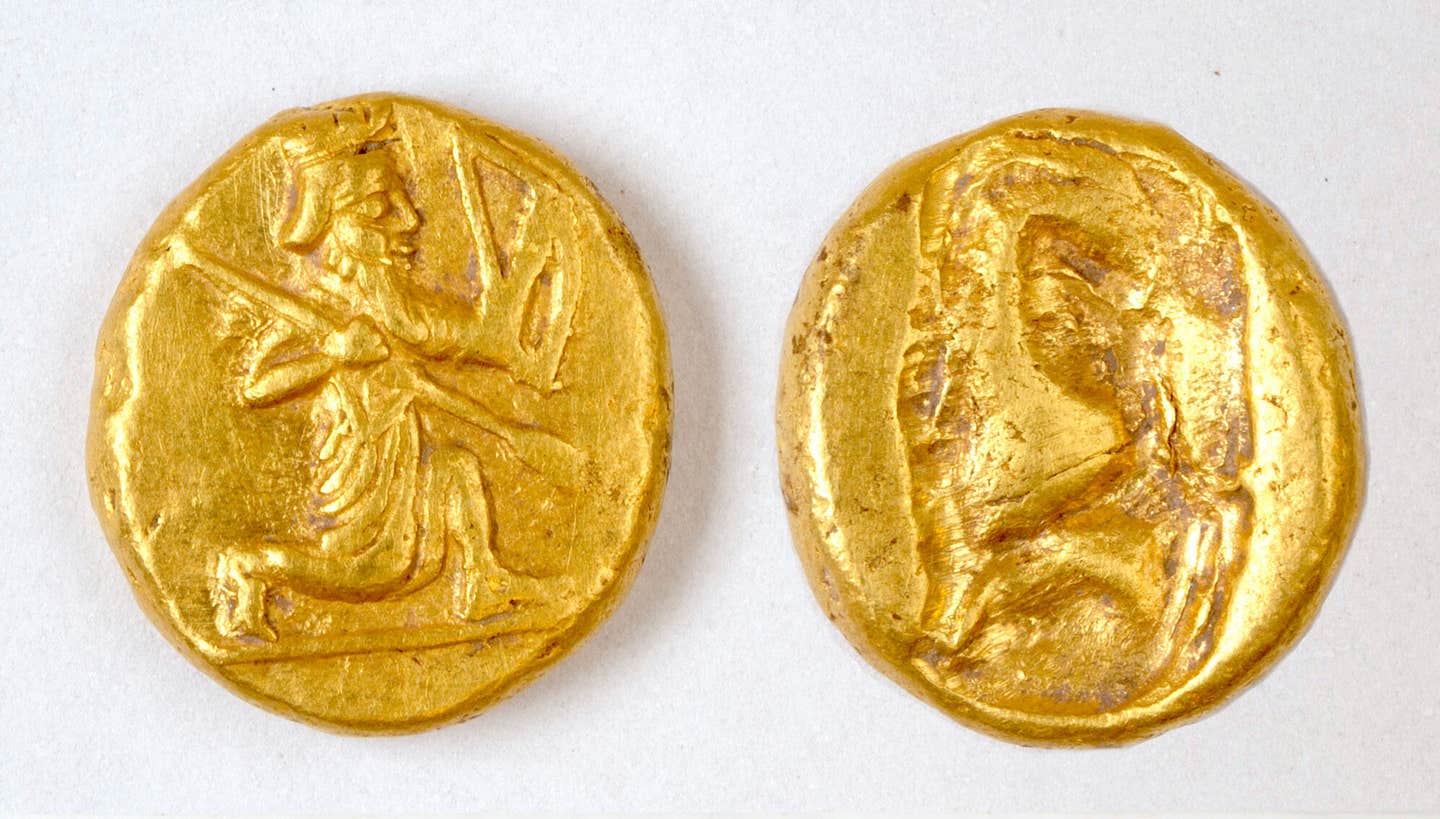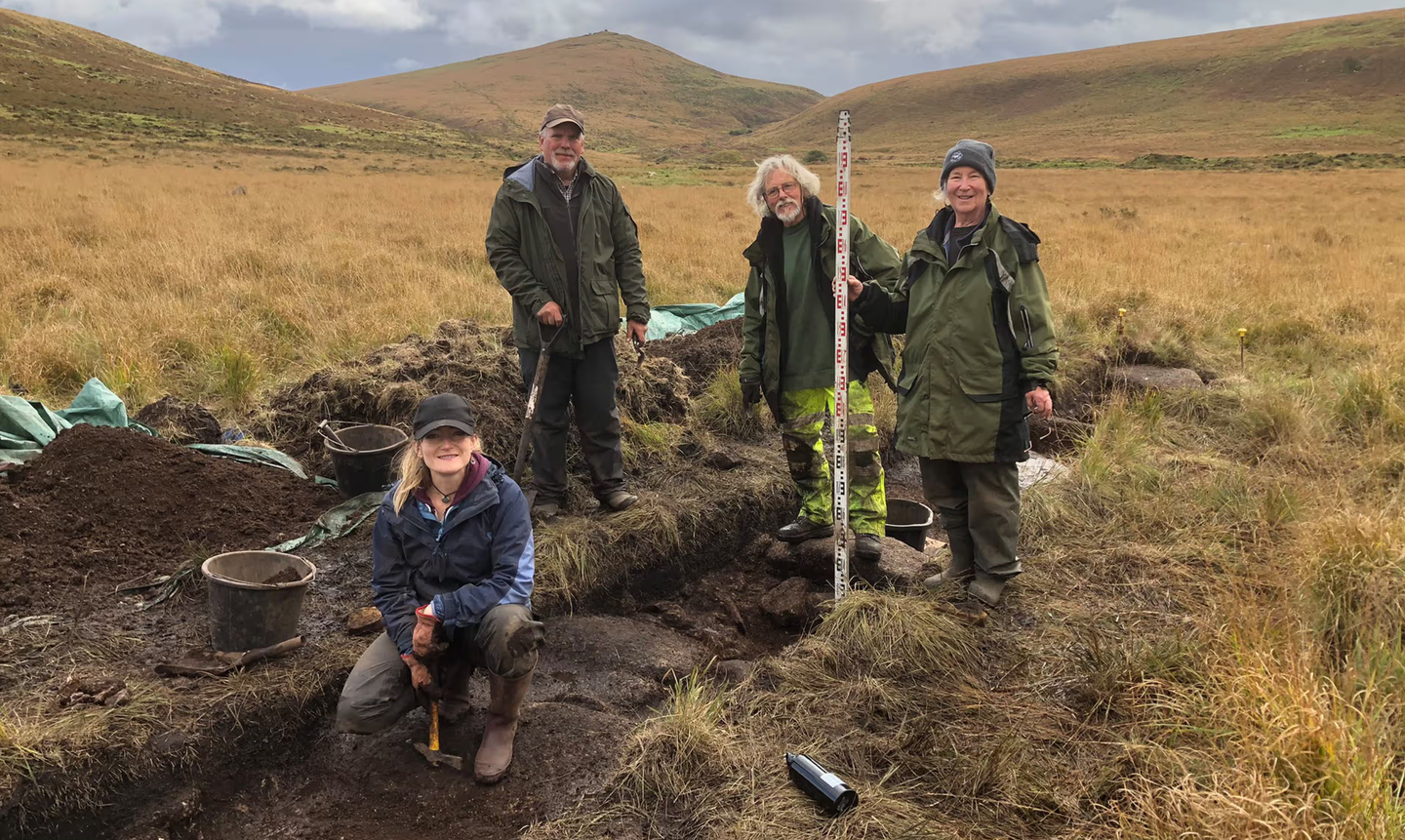Pot of gold coins found at site of ancient Greek city in Turkey
These coins, likely used to pay mercenary troops, were buried in a small pot, offering a glimpse into the city’s tumultuous past

The coins show a figure of a kneeling archer, the characteristic design of the Persian daric, a type of gold coin issued by the Persian Empire and probably minted at Sardis, 60 miles northeast of Notion. (CREDIT: Notion Archaeological Project, University of Michigan)
A remarkable discovery has been made in the ancient Greek city of Notion, located in western Turkey, where a team of researchers led by a University of Michigan archaeologist unearthed a hoard of gold coins. These coins, likely used to pay mercenary troops, were buried in a small pot, offering a glimpse into the city's tumultuous past during the Persian Empire's reign.
The coins feature a kneeling archer, a distinctive design of the Persian daric, a gold coin issued by the Persian Empire. Christopher Ratté, a professor of ancient Mediterranean art and archaeology at the University of Michigan, who also directs the Notion Archaeological Project, which discovered the coins, notes that these darics were probably minted at Sardis, about 60 miles northeast of Notion.
Dated to the fifth century B.C., this hoard provides historians with crucial data for understanding the timeline and history of the Persian daric. Ratté emphasizes the rarity and value of such a find, stating, "The discovery of such a valuable find in a controlled archaeological excavation is very rare. No one ever buries a hoard of coins, especially precious metal coins, without intending to retrieve it. So only the gravest misfortune can explain the preservation of such a treasure."
The Persian daric was minted from the late sixth century B.C. until Alexander the Great's conquest of the Persian Empire in 330 B.C. While the design of these coins remained relatively consistent, minor stylistic differences allow researchers to arrange them in a chronological sequence.
The newly discovered hoard, independently dated by other artifacts found with it, could serve as a critical anchor in this chronology. "This hoard will provide a firm date that can serve as an anchor to help fix the chronology of the entire sequence of coins," Ratté explained.
Andrew Meadows, an expert from Oxford University and former curator of coins at the British Museum and the American Numismatic Society, recognizes the significance of this discovery. He suggests that the archaeological context of the hoard, if accurately established, could refine the chronology of Achaemenid gold coinage. "This is a spectacular find … of the highest importance," Meadows remarked.
The excavations at Notion began in 2022, with the coins being uncovered in 2023. The discovery has since been made public with the permission of the Turkish Ministry of Culture and Tourism. The coins remain in Turkey, under the care of the Ephesus Archaeological Museum, where they continue to be studied.
Related Stories
Notion, with its best-preserved remains dating to the Hellenistic period between the third and first centuries B.C., has revealed evidence of even earlier habitation. In the center of the city, archaeologists excavated a large courtyard house, uncovering fragments of pottery from the fifth century B.C. This suggests that the city was inhabited earlier than previously believed. In July 2023, the team unearthed the hoard of coins buried in a small pot beneath one area of the courtyard.
Ratté describes the discovery: "The hoard was found in the corner of a room in a structure buried beneath the Hellenistic house. Presumably, it was stored there for safekeeping and for some reason never recovered." He also highlights the value of the coins in their historical context, noting that according to the Greek historian Xenophon, a single daric was equivalent to a soldier’s pay for one month.
It is believed that darics were primarily used to pay mercenary troops, and this hoard could be associated with military operations in the area around Notion. However, the exact circumstances surrounding its burial and abandonment remain a mystery. Ratté notes that many hoards of darics have been found by looters, rather than in controlled archaeological excavations, leading to a significant loss of contextual information.
"An archaeological find without contextual information is like a person suffering from amnesia—a person without memories," Ratté explains. "It is still interesting and important, but the loss of knowledge is incalculable. In the case of this hoard, we know precisely where it was found, and we have a great deal of circumstantial evidence for when it was deposited, probably in the late fifth century B.C."
Notion's history is closely tied to the Persian Empire, as it was incorporated into the empire along with other Greek cities on the west coast of Turkey in the mid-sixth century B.C. Although it gained temporary independence in the early fifth century B.C., it was soon reintegrated into the Persian Empire and remained under Persian control until Alexander the Great's conquest in 334 B.C.
Throughout the fifth century B.C., Notion found itself at the center of numerous military conflicts, often caught between the Persian and Athenian spheres of influence. One notable episode, recorded by the Greek historian Thucydides, occurred between 430 B.C. and 427 B.C. when Persian sympathizers from the nearby city of Colophon occupied part of Notion with the help of Greek and "barbarian" mercenaries. In 427 B.C., the Athenian general Paches attacked and killed these pro-Persian mercenaries, expelling the sympathizers and reorganizing Notion under Athenian control.
This turbulent period could very well explain the deposition and subsequent loss of the hoard, though other possibilities exist. In 406 B.C., a significant naval battle between Athens and Sparta took place off the coast of Notion, and later, in the 360s B.C., the region erupted into conflict again during the Great Satraps’ Revolt, when several Persian governors rebelled against the central authorities. The conventional chronology of Persian coins suggests that the hoard may date to the fourth century B.C., aligning with these events.
The Notion Archaeological Project, sponsored by the University of Michigan in cooperation with Sinop University and authorized by the Turkish Ministry of Culture and Tourism, continues to explore the city's rich history. Hazar Kaba, associate professor of archaeology at Sinop University, serves as the project's associate director.
The current field season is just beginning, and researchers hope that further excavation will clarify the archaeological context of the hoard, while ongoing study of the coins will shed more light on their date, function, and historical significance.
Note: Materials provided above by The Brighter Side of News. Content may be edited for style and length.
Like these kind of feel good stories? Get The Brighter Side of News' newsletter.
Rebecca Shavit
Science & Technology Journalist | Innovation Storyteller
Based in Los Angeles, Rebecca Shavit is a dedicated science and technology journalist who writes for The Brighter Side of News, an online publication committed to highlighting positive and transformative stories from around the world. With a passion for uncovering groundbreaking discoveries and innovations, she brings to light the scientific advancements shaping a better future. Her reporting spans a wide range of topics, from cutting-edge medical breakthroughs and artificial intelligence to green technology and space exploration. With a keen ability to translate complex concepts into engaging and accessible stories, she makes science and innovation relatable to a broad audience.



